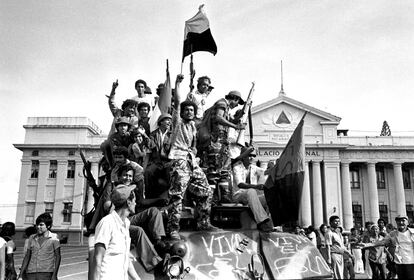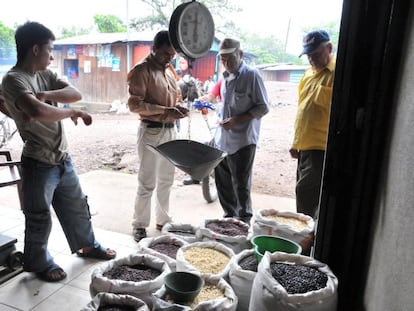Nicaragua’s ghost of revolution
45 years after Somoza’s flight, the country struggles to reckon with its past

45 years ago, the triumph of the Sandinista revolution in Nicaragua took place. It was a critical moment in Latin America, constituting the first and last time an armed leftist group came to power in the region after Cuba’s turn in 1959. Today Nicaragua, just as it was back then, is a young country. Its population has an average age of 24 (in the United States, the average is 38.5.) Fewer and fewer people can say they lived through the collapse of Somoza’s dictatorship, the revolution’s great reforms and the bloody war between the Sandinista government and the Contras.
Most Nicaraguans weren’t around for any of that. But still, our lives have been deeply impacted by the era’s conflicts, and even more so by our cloudy memories of them. When they came to power on July 19, 1979, the nine commanders of the Sandinista Front for National Liberation (FSLN) averaged around 30 years of age. In one of the continent’s poorest nations, governed for decades by a family of dictators, the youth of this new leadership symbolized hope for a dramatic renewal. At the international level, these “boys” rose above because they seemed to shatter the Cold War’s ideological barriers by declaring an innovative revolutionary model that fused respect for political pluralism with a determination to redistribute wealth — which is to say, democracy and social justice.
The latter would take priority for this revolutionary leadership, inspired in some ways by Marx, throughout its 1980s administration. In the end, they were unable to vanquish poverty and inequality due to external factors (such as U.S. support of the Contras) as well as internal ones (the administration’s own errors and excesses). But as a “paradox of history,” the revolution left as an inheritance that which had not been its most enthusiastic proposal: a transition to liberal democracy, which was consolidated in 1990 with the FSLN’s recognition of its own electoral defeat. Such was the conclusion of Sandinista writer and statesperson Sergio Ramírez in his memoir, entitled Adiós muchachos. For Nicaraguans who grew up in the 1990s and 2000s, the previous decade’s utopian project was omnipresent, its slogans and murals unmissable elements of the urban landscape. But the revolution was also an enigma and only shadows remained of the initial euphoria that is so characteristic of revolutions and their endless possibilities to put an end to backwardness and injustice. We also internalized from an early age the violence of an armed conflict that tore the social fabric, even if we still didn’t completely understand what the purpose of so much violence had been.
The war’s poorly healed traumas and unfulfilled promises of socioeconomic well-being, as well as the revolutionary decade and democratic transition, were all notorious factors in the germination of a new dictatorship. After rising to power in 2007, the Sandinista caudillo Daniel Ortega offered social peace and economic growth — while avoiding the radical redistributive measures of the past — in exchange for the centralization of power in the hands of him and his family.
When a massive wave of protests interrupted Ortega’s 2018 authoritarian consolidation, they were led by young people from the post-revolutionary generation. Some were the offspring of FSLN militants, others came from anti-Sandinista families who were dispossessed or persecuted by the 1980s government. On one hand, they conjured up the spirit of the past and borrowed symbols from the anti-Somoza insurrection. On the other, they discarded armed struggle as a means of national reconstruction. The 2018 rebellion was, for the most part, peaceful. And so, the Sandinista’s “patria libre o morir” (“free country or death”) became “patria libre para vivir” (“free country to live”).
Ortega justified the lethal repression of protestors as a way of saving the revolution, in whose steps he claimed to be following, and echoed 1980s accusations that the United States was supporting the protestors. Likewise, the government’s most loyal followers saw the demonstrations not as a demand for democracy, but as an apparition of Somoza’s counter-revolutionary movement, an attack on the memory of a political project that, despite its material failures, gave voice to large sectors of the nation who had been previously marginalized. Now, the country is in crisis, bereft of both democracy and social justice. This is due to various factors. One of them, doubtlessly, is that Nicaragua has not yet reckoned with its past. Despite the time that has passed, memory of the revolution is still polarized, even within the fragmented and exiled anti-Ortega opposition that is formed by everyone from Contra members of the military to historic Sandinistas. Instead of treating it as a complicated process that deserves to be studied and understood, it continues to be seen as something that must be simply celebrated or mourned. Those who were born after the revolution tend to see the past through the eyes of their parents and grandparents, who experienced the revolution as any revolution is experienced: as a painful struggle between the good and the bad, light and darkness.
In consequence, Nicaraguans have no shared history to tell them where they came from. Without one, it is difficult to imagine where they will go.
Sign up for our weekly newsletter to get more English-language news coverage from EL PAÍS USA Edition
Tu suscripción se está usando en otro dispositivo
¿Quieres añadir otro usuario a tu suscripción?
Si continúas leyendo en este dispositivo, no se podrá leer en el otro.
FlechaTu suscripción se está usando en otro dispositivo y solo puedes acceder a EL PAÍS desde un dispositivo a la vez.
Si quieres compartir tu cuenta, cambia tu suscripción a la modalidad Premium, así podrás añadir otro usuario. Cada uno accederá con su propia cuenta de email, lo que os permitirá personalizar vuestra experiencia en EL PAÍS.
¿Tienes una suscripción de empresa? Accede aquí para contratar más cuentas.
En el caso de no saber quién está usando tu cuenta, te recomendamos cambiar tu contraseña aquí.
Si decides continuar compartiendo tu cuenta, este mensaje se mostrará en tu dispositivo y en el de la otra persona que está usando tu cuenta de forma indefinida, afectando a tu experiencia de lectura. Puedes consultar aquí los términos y condiciones de la suscripción digital.
More information

With prices soaring, 86.8% of Nicaraguans cannot afford to buy essentials

Nicaragua’s Daniel Ortega establishes diplomatic ties with the Taliban
Archived In
Últimas noticias
Most viewed
- Alain Aspect, Nobel laureate in physics: ‘Einstein was so smart that he would have had to recognize quantum entanglement’
- Alvin Hellerstein, a 92-year-old judge appointed by Bill Clinton, to preside over Maduro’s trial in New York
- Gilles Lipovetsky: ‘If you want to live better and fall in love, take Prozac, don’t look to philosophy’
- Cuba confirms death of 32 of its citizens in the US attack against Venezuela
- Why oil has been at the center of Venezuela-US conflicts for decades








































